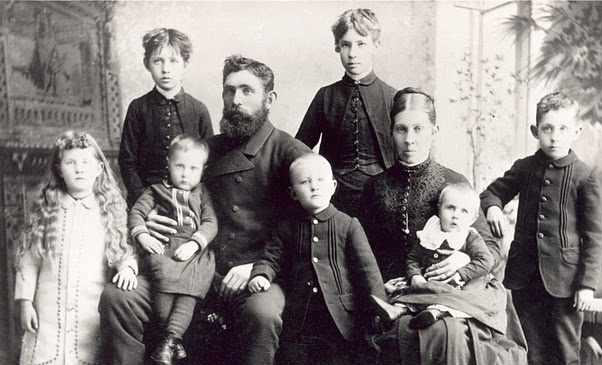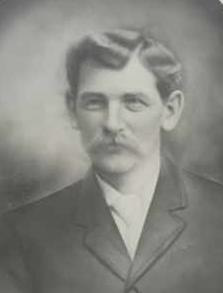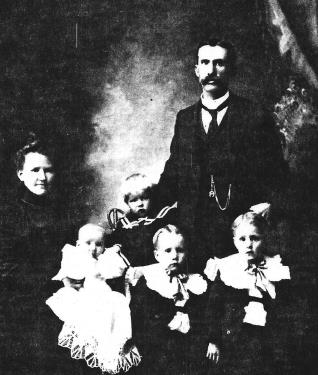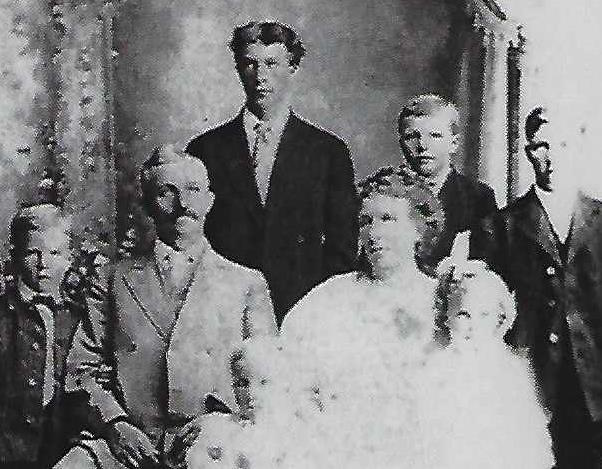
Pre 1899, Early Pioneers of Magrath, AB, Canada (abt. 1893).
Baldwin, George James & Eliza Mary Davis
George Baldwin (22) had a ranch near where the
town of Magrath was later established in 1899. Born
in Quebec, Canada, his father had died young, and his
mother moved west. George went to Alberta at about
15 years of age. He lived with friends and drove an 8-
span bull team to Ft. Benton, Montana and back.
George lived at Fort Whoop Up and with Tom
Purcell, attending the big cattle roundups. He helped
supply beef for construction crews on the railway to
B.C. In 1902, George moved 50 miles north to the
Carmangay area. He later (1905) wed Eliza ‘Lila’ Mary
Davis. They had about 4-5 children, though the oldest,
Georgina (‘Ena) may have come with her mother from Idaho.
Sources: Magrath History & Museum Assn; Irrigation Builders I (1974); FamilySearch (Sep 2023).
Baldwin, George James & Eliza Mary Davis
George Baldwin (22) had a ranch near where the
town of Magrath was later established in 1899. Born
in Quebec, Canada, his father had died young, and his
mother moved west. George went to Alberta at about
15 years of age. He lived with friends and drove an 8-
span bull team to Ft. Benton, Montana and back.
George lived at Fort Whoop Up and with Tom
Purcell, attending the big cattle roundups. He helped
supply beef for construction crews on the railway to
B.C. In 1902, George moved 50 miles north to the
Carmangay area. He later (1905) wed Eliza ‘Lila’ Mary
Davis. They had about 4-5 children, though the oldest,
Georgina (‘Ena) may have come with her mother from Idaho.
Sources: Magrath History & Museum Assn; Irrigation Builders I (1974); FamilySearch (Sep 2023).
 The Homer Brown family.
The Homer Brown family.
Pre 1899, Early Pioneers, Magrath, AB, Canada (abt. 1898).
Brown, Homer M. & Lydia Jane Brown
In 1898, Homer Brown (44) and his son James settled in the Spring Coulee area. It was about 10 miles west of the soon-to-be village of Magrath. They built a large irrigation canal nearby and bought 1,000 acres of land. Late the following year, the family joined them from Utah. The location was described as an ocean of grass, with not a single tree in sight.
About 1900, the Browns were called by the Church to establish a rest-station in Spring Coulee. A Branch of the Church was organized. The Brown family removed to Cardston in the spring of 1902, to facilitate the children’s schooling.
Sources: Magrath Census (Mar 1901); FamilySearch (Oct 2023).
Brown, Homer M. & Lydia Jane Brown
In 1898, Homer Brown (44) and his son James settled in the Spring Coulee area. It was about 10 miles west of the soon-to-be village of Magrath. They built a large irrigation canal nearby and bought 1,000 acres of land. Late the following year, the family joined them from Utah. The location was described as an ocean of grass, with not a single tree in sight.
About 1900, the Browns were called by the Church to establish a rest-station in Spring Coulee. A Branch of the Church was organized. The Brown family removed to Cardston in the spring of 1902, to facilitate the children’s schooling.
Sources: Magrath Census (Mar 1901); FamilySearch (Oct 2023).
 Emerette Brown
Emerette Brown
Pre 1899, Early Pioneers, Magrath, AB, Canada (abt. 1898).
Brown, Walter H. & Emerette Brown
About 1898, Walter Brown (40) from Hunter, Utah was called on a 3-year mission to Spring Coulee. This was about 10 miles west of where the village of Magrath would soon be established. A lot of construction on a major irrigation canal was to take place near there and a relief station for travellers was deemed essential. Walter and his wife, Emerette (also surnamed Brown), worked with Homer M. Brown (Walter’s brother) and his wife who lived nearby.
Walter also focused on promoting the settlement of the area. Under the direction of C.O. Card, he helped to purchase and deliver lumber for the construction of the first 6 houses in Magrath. And together with others, he and his brother set up a little tent store to distribute goods to the construction camps along the canal. Walter helped to introduce Turkey Red wheat as a stable crop in Southern Alberta. He later returned to Utah.
Sources: Magrath Census (1901); Irrigation Builders I (1974); FamilySearch (Oct 2023).
Brown, Walter H. & Emerette Brown
About 1898, Walter Brown (40) from Hunter, Utah was called on a 3-year mission to Spring Coulee. This was about 10 miles west of where the village of Magrath would soon be established. A lot of construction on a major irrigation canal was to take place near there and a relief station for travellers was deemed essential. Walter and his wife, Emerette (also surnamed Brown), worked with Homer M. Brown (Walter’s brother) and his wife who lived nearby.
Walter also focused on promoting the settlement of the area. Under the direction of C.O. Card, he helped to purchase and deliver lumber for the construction of the first 6 houses in Magrath. And together with others, he and his brother set up a little tent store to distribute goods to the construction camps along the canal. Walter helped to introduce Turkey Red wheat as a stable crop in Southern Alberta. He later returned to Utah.
Sources: Magrath Census (1901); Irrigation Builders I (1974); FamilySearch (Oct 2023).
 Levi Harker.
Levi Harker.
Pre 1899, Early Pioneers of Magrath, AB, Canada (abt. 1892)
Harker, Levi & Martha Burns
Levi Harker (30) ranged sheep along the Pothole River and to the south along the Milk River Ridge after 1892. He and Martha Burns first brought their young family to Cardston, Alberta. Likely during the mid to late 1890’s, Levi was riding his horse along the northern slope of the Ridge. He looked out onto the prairie and “a vision opened to his view …”
“He saw the country crisscrossed with wire fences, divided into fields ... Well-travelled roads ran between the section lines; a canal wound its way along the slope … and fields of grain were everywhere ... On the north bank of the Pothole River, he saw a prosperous town with beautiful trees and comfortable homes. He … saw beneath the rich soil, reservoirs of gas and oil … A voice seemed to say, ‘You will see all this come to pass and more.”
Sources: Magrath History & Museum Assn; Irrigation Builders I (1974); FamilySearch (May 2022).
Harker, Levi & Martha Burns
Levi Harker (30) ranged sheep along the Pothole River and to the south along the Milk River Ridge after 1892. He and Martha Burns first brought their young family to Cardston, Alberta. Likely during the mid to late 1890’s, Levi was riding his horse along the northern slope of the Ridge. He looked out onto the prairie and “a vision opened to his view …”
“He saw the country crisscrossed with wire fences, divided into fields ... Well-travelled roads ran between the section lines; a canal wound its way along the slope … and fields of grain were everywhere ... On the north bank of the Pothole River, he saw a prosperous town with beautiful trees and comfortable homes. He … saw beneath the rich soil, reservoirs of gas and oil … A voice seemed to say, ‘You will see all this come to pass and more.”
Sources: Magrath History & Museum Assn; Irrigation Builders I (1974); FamilySearch (May 2022).

Pre 1899, Early Pioneers of Magrath, AB, Canada (abt. 1895).
Kenney, Edward & Olga Ellen Johnson
Ted Kenney (22) came to Alberta from Holden,
Utah around 1895. He helped start the McIntyre
Ranch (64,000 ac), 12 miles south of where
Magrath would be established in 1899. He was its
foreman. Ted had earlier wed Ellen Johnson in
Utah and moved his young family to live in nearby
Cardston (30 miles west).
At their home, Ellen milked the cows, was a fine
seamstress, horsewoman, and cook. She was
“frugal but generous and kindly….
” Ted later won
and lost big, in ranching, cattle, and oil wells. He
was “not a religious man, but [one] known among
his associates as an honest man … a firm, but kind and generous father.”
Sources: Irrigation Builders I (1974); FamilySearch (Sep 2023).
Kenney, Edward & Olga Ellen Johnson
Ted Kenney (22) came to Alberta from Holden,
Utah around 1895. He helped start the McIntyre
Ranch (64,000 ac), 12 miles south of where
Magrath would be established in 1899. He was its
foreman. Ted had earlier wed Ellen Johnson in
Utah and moved his young family to live in nearby
Cardston (30 miles west).
At their home, Ellen milked the cows, was a fine
seamstress, horsewoman, and cook. She was
“frugal but generous and kindly….
” Ted later won
and lost big, in ranching, cattle, and oil wells. He
was “not a religious man, but [one] known among
his associates as an honest man … a firm, but kind and generous father.”
Sources: Irrigation Builders I (1974); FamilySearch (Sep 2023).

Pre 1899, Early Pioneers of Magrath, AB, Canada (abt. 1896).
McCarty, Charles & Mary Mercer
Charles McCarty (46) moved from American Fork, Utah into the Spring Coulee area. It was about 10 miles west of where Magrath would be established in 1896. He had earlier married Mary Mercer (1876) and they had 4 surviving children.
Charley purchased a ranch of 17,000 acres. The ranch of William McIntyre abutted him on the south, with the James Eldredge ranch to the west. The McCarty family lived on the ranch in the summer and in nearby Cardston (15 miles west) during winter so the boys could attend school. A 1901 Census shows the McCarty family as living in the Magrath area at the time.
Sources: Irrigation Builders I (1974); Magrath Census (Mar 1901); FamilySearch (Oct 2023).
McCarty, Charles & Mary Mercer
Charles McCarty (46) moved from American Fork, Utah into the Spring Coulee area. It was about 10 miles west of where Magrath would be established in 1896. He had earlier married Mary Mercer (1876) and they had 4 surviving children.
Charley purchased a ranch of 17,000 acres. The ranch of William McIntyre abutted him on the south, with the James Eldredge ranch to the west. The McCarty family lived on the ranch in the summer and in nearby Cardston (15 miles west) during winter so the boys could attend school. A 1901 Census shows the McCarty family as living in the Magrath area at the time.
Sources: Irrigation Builders I (1974); Magrath Census (Mar 1901); FamilySearch (Oct 2023).

Pre 1899, Early Pioneers of Magrath, AB, Canada (abt. 1894).
McIntyre, William Howell & Phoebe O. H. Chase
A significant development in the Magrath area was the formation of McIntyre Ranch in 1894. Its headquarters along Milk River Ridge, was 12 miles south of where the town of Magrath would soon be formed. In 1878, McIntyre married Phoebe Ogden Chase of Salt Lake City, Utah. They had 8 children. He bought his extensive tract of rangeland from C.A. Magrath, a land agent for the local railroad, eventually amounting to 64,000 acres in one block.
William Howell was known as a man of high moral character. His son, Billy McIntyre (b. 1887) gradually took over the management of the ranch and is the name many locals associate with it in the early 1900’s. Over the years, McIntyre Ranch was the source of employment for many young men from the region.
Sources: Magrath History & Museum Assn., Irrigation Builders I (1974), FamilySearch (July 2023).
McIntyre, William Howell & Phoebe O. H. Chase
A significant development in the Magrath area was the formation of McIntyre Ranch in 1894. Its headquarters along Milk River Ridge, was 12 miles south of where the town of Magrath would soon be formed. In 1878, McIntyre married Phoebe Ogden Chase of Salt Lake City, Utah. They had 8 children. He bought his extensive tract of rangeland from C.A. Magrath, a land agent for the local railroad, eventually amounting to 64,000 acres in one block.
William Howell was known as a man of high moral character. His son, Billy McIntyre (b. 1887) gradually took over the management of the ranch and is the name many locals associate with it in the early 1900’s. Over the years, McIntyre Ranch was the source of employment for many young men from the region.
Sources: Magrath History & Museum Assn., Irrigation Builders I (1974), FamilySearch (July 2023).
 James Perry (R) & Lettice Wall.
James Perry (R) & Lettice Wall.
Pre 1899, Early Pioneers of Magrath, AB, Canada (abt. 1885).
Perry, James & Lettice Wall
About the late 1880’s, James Perry ranched in the Pothole River area south of Lethbridge. Born in England in 1846, he married Lettice Hall, and they began a family. They first immigrated to Baltimore, USA, and then to Lethbridge, Alberta, Canada in 1885.
The Perry’s were amongst the first settlers, bringing 7 children. Lettice recalls being visited by native Indians, dressed in their spotlessly clean Hudson Bay blankets. Her philosophy on life was that, “If you want to be happy, be busy in your home and have plenty of children." James worked at the coal mines in Lethbridge, then ranched. In 1901 the family moved 70 miles east, near Bow Island, where they raised cattle and horses.
Sources: Irrigation Builders I (1974); FamilySearch (Aug 2023).
Perry, James & Lettice Wall
About the late 1880’s, James Perry ranched in the Pothole River area south of Lethbridge. Born in England in 1846, he married Lettice Hall, and they began a family. They first immigrated to Baltimore, USA, and then to Lethbridge, Alberta, Canada in 1885.
The Perry’s were amongst the first settlers, bringing 7 children. Lettice recalls being visited by native Indians, dressed in their spotlessly clean Hudson Bay blankets. Her philosophy on life was that, “If you want to be happy, be busy in your home and have plenty of children." James worked at the coal mines in Lethbridge, then ranched. In 1901 the family moved 70 miles east, near Bow Island, where they raised cattle and horses.
Sources: Irrigation Builders I (1974); FamilySearch (Aug 2023).
Pre 1899, Early Pioneers of Magrath, AB, Canada (abt. 1898).
Peterson, Andrew O. & Wilhelmina D. Finlayson
Andrew O. Peterson (no photo) was born in Manti, Utah, in 1880. He came to Alberta as a single man in 1898 (18), living in the Spring Coulee area. This was just west of where the town of Magrath would be established a year later. Andrew broke much of the sod between Spring Coulee and Magrath.
About 1904, Andrew may have begun farming closer to town. In 1914 (age 34) he married Ina Finlayson (no photo). She had earlier come to Magrath with her father and mother. She brought a daughter to her new marriage (Ada Gwendolyn Finlayson) who was born (1901) in Utah. The Peterson’s had 4 children of their own. One of these, Gladys Peterson, married Phillip John Sheer of Magrath.
Sources: Magrath History & Museum Assn; Irrigation Builders I (1974); Family Search (Sep 2023).
Peterson, Andrew O. & Wilhelmina D. Finlayson
Andrew O. Peterson (no photo) was born in Manti, Utah, in 1880. He came to Alberta as a single man in 1898 (18), living in the Spring Coulee area. This was just west of where the town of Magrath would be established a year later. Andrew broke much of the sod between Spring Coulee and Magrath.
About 1904, Andrew may have begun farming closer to town. In 1914 (age 34) he married Ina Finlayson (no photo). She had earlier come to Magrath with her father and mother. She brought a daughter to her new marriage (Ada Gwendolyn Finlayson) who was born (1901) in Utah. The Peterson’s had 4 children of their own. One of these, Gladys Peterson, married Phillip John Sheer of Magrath.
Sources: Magrath History & Museum Assn; Irrigation Builders I (1974); Family Search (Sep 2023).
 Hyrum W. Taylor & Louisa Ann Siddoway family.
Hyrum W. Taylor & Louisa Ann Siddoway family.
Pre 1899, Early Pioneers of Magrath, AB, Canada (abt. 1893).
Taylor, Hyrum Whittaker & Louisa Ann Siddoway
Hyrum W. Taylor, the son of Church President John Taylor, came to Alberta in 1893. He had married Louisa Ann Siddoway in Utah. The couple had 6 children. Their home was a sheep ranch on the St. Mary River, 9 miles NW of where Magrath was established in 1899.
With the town’s construction, the Taylor’s moved into Magrath about 1900. Hyrum was a carpenter who helped build the Assembly Hall and the 2nd Ward Church. Mrs. Taylor, a certified schoolteacher, took part in and directed many home dramatics.
Sources: Irrigation Builders I (1974), FamilySearch (July 2023).
Taylor, Hyrum Whittaker & Louisa Ann Siddoway
Hyrum W. Taylor, the son of Church President John Taylor, came to Alberta in 1893. He had married Louisa Ann Siddoway in Utah. The couple had 6 children. Their home was a sheep ranch on the St. Mary River, 9 miles NW of where Magrath was established in 1899.
With the town’s construction, the Taylor’s moved into Magrath about 1900. Hyrum was a carpenter who helped build the Assembly Hall and the 2nd Ward Church. Mrs. Taylor, a certified schoolteacher, took part in and directed many home dramatics.
Sources: Irrigation Builders I (1974), FamilySearch (July 2023).
Pre 1899, Early Pioneers of Magrath, AB, Canada (abt. 1895).
Williamson, Charles R. & Jennie Miller
Charles R. Williamson (no photo) came from Ontario to North Battleford, Saskatchewan, being there during the Riel Rebellion. He later moved to Lethbridge and raised a family with Jennie Miller (no photo), also from Ontario. They had 4-5 children. About 1895, Charles (age 34) began ranching on land around 5 miles south of where Magrath would later be established in 1899. He built a large rock house having a bay window, in a deep coulee now flooded by Jensen Dam. The Williamson’s and the George Baldwin family were close neighbours in the area.
With the coming of more settlers, about 1903 Mr. Williamson and other ranchers chose to move their cattle to pasture about 50 miles north, in the Carmangay area around the Little Bow River. He located near George Baldwin and Tom Purcell, whom he had known from his days in Magrath.
Sources: Irrigation Builders I (1974); FamilySearch (Aug 2023).
Williamson, Charles R. & Jennie Miller
Charles R. Williamson (no photo) came from Ontario to North Battleford, Saskatchewan, being there during the Riel Rebellion. He later moved to Lethbridge and raised a family with Jennie Miller (no photo), also from Ontario. They had 4-5 children. About 1895, Charles (age 34) began ranching on land around 5 miles south of where Magrath would later be established in 1899. He built a large rock house having a bay window, in a deep coulee now flooded by Jensen Dam. The Williamson’s and the George Baldwin family were close neighbours in the area.
With the coming of more settlers, about 1903 Mr. Williamson and other ranchers chose to move their cattle to pasture about 50 miles north, in the Carmangay area around the Little Bow River. He located near George Baldwin and Tom Purcell, whom he had known from his days in Magrath.
Sources: Irrigation Builders I (1974); FamilySearch (Aug 2023).
